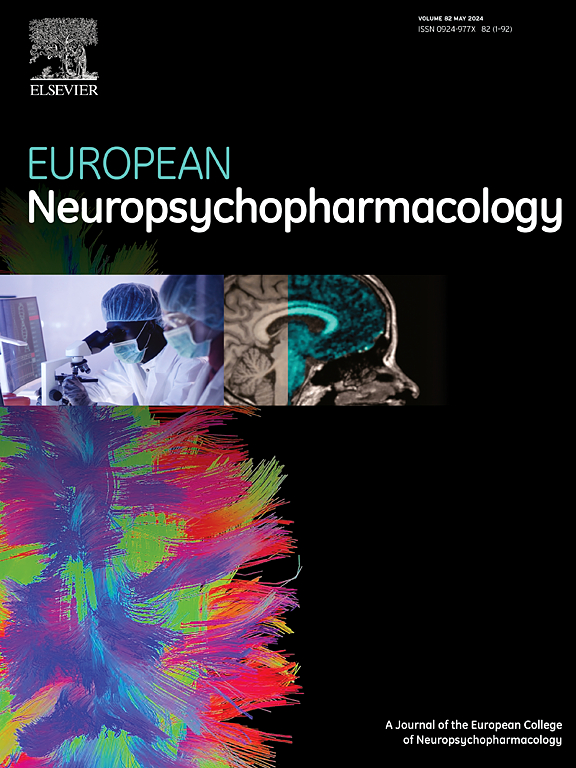Improvements in functioning and workplace productivity with esketamine nasal spray versus quetiapine extended release in patients with treatment resistant depression: Findings from a 32-week randomised, open-label, rater-blinded phase IIIb study
IF 6.1
2区 医学
Q1 CLINICAL NEUROLOGY
引用次数: 0
Abstract
Patients with treatment resistant depression (TRD) experience a greater negative impact on their functioning and productivity at home and in the workplace versus treatment-responsive patients. Here, we report the effects of esketamine nasal spray (NS) versus quetiapine extended release (XR) on functioning, work productivity and activity impairment. ESCAPE‑TRD (NCT04338321) was a 32-week randomised, open‑label, rater‑blinded, active‑controlled phase IIIb study comparing the efficacy and safety of esketamine NS versus quetiapine XR, both alongside an ongoing selective serotonin reuptake inhibitor or serotonin norepinephrine reuptake inhibitor (SSRI/SNRI), in patients with TRD. Patient functioning was assessed via the Sheehan Disability Scale (SDS; functional remission ≤6). Absenteeism, presenteeism, work productivity loss and activity impairment over time were assessed using the Work Productivity and Activity Impairment: Depression (WPAI:D) questionnaire. Results were cumulated over the entire study duration. Esketamine NS-treated patients (N = 336) experienced 43.2 % more weeks with functional remission versus quetiapine XR-treated patients (N = 340) over the 32-week study period (difference: 2.0 weeks [95 % CI: 0.7, 3.3]; p = 0.0023 [ANCOVA models]). Up to Week 32, esketamine NS-treated patients experienced an 11.9 % reduction in productivity loss due to absenteeism (difference: −1.1 weeks [95 % CI: −2.9, 0.7]; p = 0.2285) and a 14.2 % reduction in overall work productivity loss (difference: –2.3 weeks, 95 % CI: [–3.9, –0.7] p = 0.0045) versus quetiapine XR-treated patients, based on mixed models for repeated measures. Patients receiving esketamine NS experienced greater improvements in functioning and productivity over 32 weeks versus quetiapine XR. These improvements demonstrate the clinical and functional benefit of treatment with esketamine NS for patients with TRD.
艾氯胺酮鼻喷雾剂与喹硫平缓释对治疗性抑郁症患者功能和工作效率的改善:来自一项32周随机、开放标签、非盲法iii期ib研究的结果
难治性抑郁症(TRD)患者在家庭和工作场所的功能和生产力受到的负面影响比治疗反应良好的患者更大。在这里,我们报告了艾氯胺酮鼻腔喷雾剂(NS)与喹硫平缓释片(XR)在功能、工作效率和活动障碍方面的影响。ESCAPE - TRD (NCT04338321)是一项为期32周的随机、开放标签、非盲、主动对照iii期ib研究,比较艾氯胺酮NS与喹硫平XR的疗效和安全性,同时在TRD患者中使用选择性5 -羟色胺再摄取抑制剂或5 -羟色胺去甲肾上腺素再摄取抑制剂(SSRI/SNRI)。通过Sheehan残疾量表(SDS;功能缓解≤6)。使用工作效率和活动障碍:抑郁症(WPAI:D)问卷对旷工、出勤、工作效率下降和活动障碍进行了长期评估。结果是在整个研究期间累积的。在32周的研究期间,艾氯胺酮ns治疗的患者(N = 336)与喹硫平xr治疗的患者(N = 340)相比,功能缓解周数多43.2%(差异:2.0周[95% CI: 0.7, 3.3];p = 0.0023 [ANCOVA模型])。截至第32周,艾氯胺酮ns治疗的患者因缺勤导致的生产力损失减少了11.9%(差异:- 1.1周[95% CI: - 2.9, 0.7];p = 0.2285),根据重复测量的混合模型,与喹硫平xr治疗的患者相比,总体工作效率损失减少14.2%(差异:-2.3周,95% CI: [-3.9, -0.7] p = 0.0045)。与喹硫平XR相比,接受艾氯胺酮NS治疗的患者在32周内的功能和生产力有更大的改善。这些改善表明艾氯胺酮NS治疗TRD患者的临床和功能益处。
本文章由计算机程序翻译,如有差异,请以英文原文为准。
求助全文
约1分钟内获得全文
求助全文
来源期刊

European Neuropsychopharmacology
医学-精神病学
CiteScore
10.30
自引率
5.40%
发文量
730
审稿时长
41 days
期刊介绍:
European Neuropsychopharmacology is the official publication of the European College of Neuropsychopharmacology (ECNP). In accordance with the mission of the College, the journal focuses on clinical and basic science contributions that advance our understanding of brain function and human behaviour and enable translation into improved treatments and enhanced public health impact in psychiatry. Recent years have been characterized by exciting advances in basic knowledge and available experimental techniques in neuroscience and genomics. However, clinical translation of these findings has not been as rapid. The journal aims to narrow this gap by promoting findings that are expected to have a major impact on both our understanding of the biological bases of mental disorders and the development and improvement of treatments, ideally paving the way for prevention and recovery.
 求助内容:
求助内容: 应助结果提醒方式:
应助结果提醒方式:


